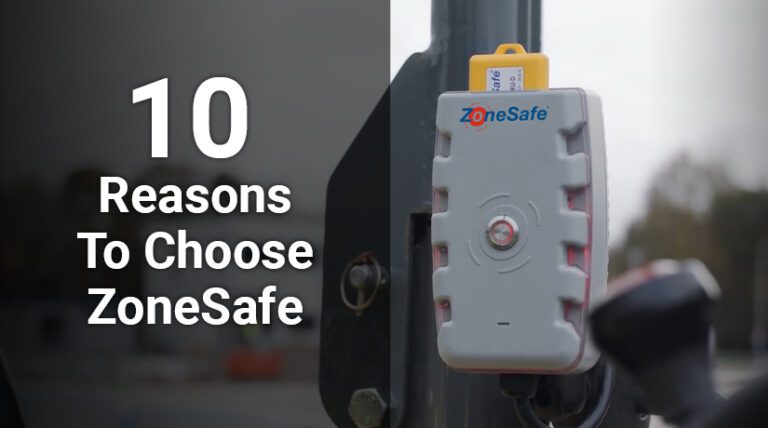Dealing with blind spots is a common problem that causes thousands of accidents in busy workplaces every year, and a blind spot warning system can be instrumental in preventing these incidents. Entry/exits, corners, intersections, and crossings all present the risk of blind spots. Blind spots on vehicles are also an issue, especially for vehicles carrying loads such as forklifts, reach stackers, and shovel loaders, where the driver’s view is obstructed by the load or by the design of the vehicle itself.
It’s not always possible to see all around the area around the vehicle using just the mirrors, so extra care must be taken to counteract the issue of blind spots to prevent accidents.
Be Aware
Good situational awareness is crucial in all high-risk workplaces. Accidents can happen in minutes, often with little or no warning, so workers must be aware of the environment and hazards around them. Operators will be aware of blind spots, such as those caused by vehicle design or site layout, and they should be referenced in regular training sessions so that everyone knows to take extra care in that area or when operating the vehicle.
But blind spots aren’t just a problem in fixed locations – they can crop up during the day with little or no warning. A large load on the front of a forklift, a change in site layout due to obstruction, reduced lighting, dust and smoke, and even bad weather can make a massive difference to visibility on the day and create a new blind spot for drivers and pedestrians to deal with.
Maintaining good situational awareness and taking extra precautions is key to addressing the risk and helping to avoid an accident. Blind spots are unavoidable, but there are measures that can be taken to address the issue, such as a blind spot warning system. Read on to find out more.
Safety Measures
It doesn’t matter how proficient a driver is, they can still suffer from limited visibility due to blind spots and need extra care and attention. Dealing with blind spots can be one of the most significant challenges for drivers. Forklifts are very commonly used across a wide range of sectors and are known to present the issue of blind spots. The vehicle’s design means the driver can’t always see around the load on the front, and reversing presents even greater challenges. However, the risk of accidents can be reduced when appropriate safety measures and equipment are implemented.
Dealing With Blind Spots
There are lots of measures that can be taken to counteract blind spots. Some common approaches include:
Buddy System – the buddy system places extra people around the area to guide the vehicle through a blind spot. This method is simple and effective – it requires good communication and is a proven method in counteracting blind spots. However, the system relies on having enough people available to buddy up.
Reversing – it is reported that around 50% of forklift accidents take place whilst reversing. This is one of the most dangerous manoeuvres for a vehicle in the workplace. Applying a robust safety procedure for reversing, creating specific reversing areas or removing the need altogether can significantly help prevent accidents. Further information about reversing from The HSE can be found here.
Mirrors – strategically placed mirrors in specific work locations or attached to the vehicle will help increase visibility for the driver. Hence, they have a clearer picture of the hazards around them. This is an effective measure, but it isn’t fool proof, as there is still the risk of blind spot areas that aren’t in view.
Speed – should be controlled anywhere where pedestrians and vehicles are working alongside each other, and it must be significantly reduced around known blind spot areas. This helps to keep the driver alert and gives them a better chance of stopping if a pedestrian or hazard presents itself.
Horns – sounding horns to raise awareness around blind spot areas alert pedestrians to the approaching vehicle. This is a simple measure but does help; however, this relies on others hearing the horn, which can be missed in a noisy environment.
Effective Blind Spot Warning System
All of these measures, applied alone or in conjunction, will help but are not always completely reliable, particularly if the blind spot is caused by a changing environmental issue such as poor light or when a large load obstructs vision. Blind spot warning systems such as ZoneSafe’s active signage and pedestrian detection sensor can address blind spots in all conditions and offer a highly reliable way of alerting drivers and pedestrians to risks around blind spots.
Active Signage
ZoneSafe sensor-activated signage sits dormant until a vehicle approaches. Once the vehicle enters a defined parameter, the signage automatically illuminates and flashes to alert everyone in the area to the presence of risk. This automatically raises awareness and reduces the chance of an accident.
The illumination of the signage also counteracts sign clutter and sign blindness, a common problem in high-risk areas. It is a highly effective tool in addressing the danger of blind spots and can significantly enhance safety in the workplace.
Proximity Warning
ZoneSafe proximity warning solutions offer peace of mind in high-risk workplaces by immediately alerting drivers and pedestrians to risk, raising awareness through a blind spot warning system and reducing the chance of an accident.
The highly intuitive system ‘sees’ around corners and through smoke, darkness, and dust to efficiently address blind spots in all workplace conditions.
Blind spots are a common problem in many workplace accidents, but ZoneSafe technology can remove the risk. Click here for more information about ZoneSafe’s range of solutions.
Contact ZoneSafe to discuss your workplace safety concerns and learn how ZoneSafe systems help to address blind spots.
Call us or send an email:
+44 (0) 1202 868000
sales@zonesafe.com
Other news you may be interested in:




